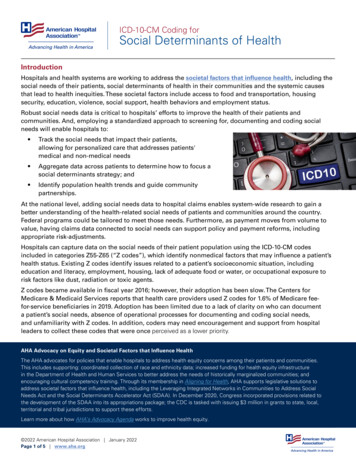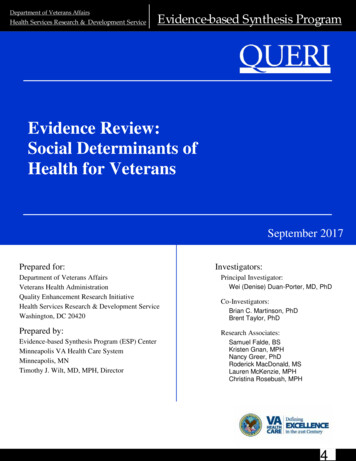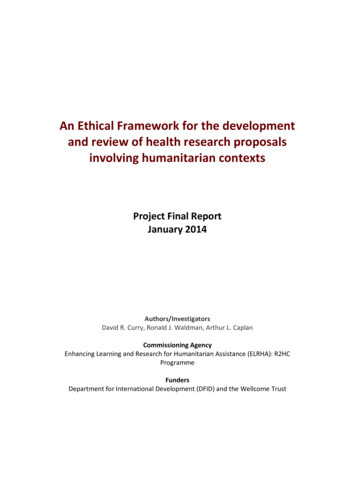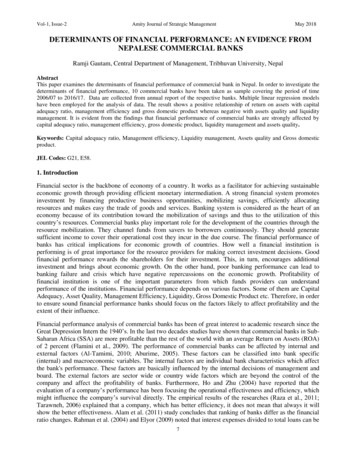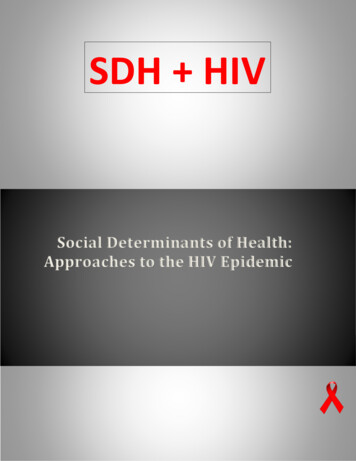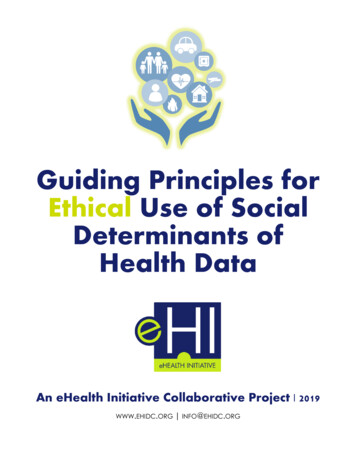
Transcription
Guiding Principles forEthical Use of SocialDeterminants ofHealth DataAn eHealth Initiative Collaborative Project 2019WWW.EHIDC.ORG INFO@EHIDC.ORG
OvervieweHealth Initiative’s (eHI) Guiding Principles for Ethical Use of Social Determinants of Health Dataoffers guidance on the evolving matter of Social Determinants of Health (SDOH) and its relateddata use for healthcare purposes. Using SDOH is unchartered territory in both policy andpractice. eHI puts forth an ethical framework for SDOH data, specifically five guiding principlesin the areas of: Care CoordinationRecognizing Risk Through SDOH AnalyticsMapping Community Resources and Identifying GapsService and Impact AssessmentCustomizing Health Services and InterventionsThe Guiding Principles for Ethical Use of Social Determinants of Health Data were developed aspart of a SDOH collaborative. eHI is an independent, non-profit organization that convenesexecutives from various healthcare stakeholder groups to discuss, identify, and share bestpractices, which transform the delivery of healthcare. The work of the SDOH collaborativefocused on educating and guiding industry stakeholders and policy makers on the value ofleveraging SDOH data for maximum good in healthcare, while addressing SDOH privacy andsecurity concerns.eHI and its coalition of members focus on education, research, and advocacy to improve quality,safety, and efficiency in healthcare. eHI promotes data sharing, technology, and innovation toenhance population health, consumer experiences, and lowers costs. The eHealth ResourceCenter is a clearinghouse and go-to resource for industry. For more information, visit ehidc.org.BackgroundHealth encompasses many facets of our lives and is more than physicalwell-being. Health begins in our homes, neighborhoods, schools,communities, and workplaces and is influenced by a number of factors.According to the World Health Organization, “social determinants ofhealth are the conditions in which people are born, grow, live, work andage. These circumstances are shaped by the distribution of money, powerand resources at global, national and local levels.”1According to Healthy People 2020, a U.S. Department of Health and Human Services (HHS)initiative providing science-based, 10-year national objectives for improving the health of allAmericans, SDOH are typically categorized in five areas—Economic Stability, Education, Social& Community Context, Health & Healthcare, and Neighborhood & Built Environment—and canaffect a wide range of health, functioning, and quality-of-life outcomes and risks.2 The CountyHealth Rankings (CHR) model, developed by the Robert Wood Johnson Foundation and theUniversity of Wisconsin Population Health Institute, demonstrates that factors related to socialand economic status and physical environment exert a greater influence on health than otherindividual modifiable factors, such as health behaviors and clinical care.31https://www.who.int/social determinants/sdh lt/files/Hood AmJPrevMed 2015.pdf2EHEALTH I NITIATIVE Guiding Principles for Ethical Use of SDOH Data2
By integrating SDOH insights into care plans, healthcare stakeholders can recognize the needfor, and enable access to, additional services or interventions for individuals, such as programsrelated to accessing healthy food, providing reliable housing, or helping patients manageisolation and loneliness, ultimately driving better health and wellness outcomes. The move tovalue-based care models makes it imperative for providers and care givers to have access tocomplete patient information, which enables care of the individual beyond the clinical condition.Organizations and researchers have recognized the impact of SDOH. Research and programsthat evaluate and address the social, economic, and environmental factors that influence healthare increasingly important and their relevance is demonstrable. Some examples include: The World Health Organization created the Commission on Social Determinants of Healthto draw the attention of governments and society to SDOH and to eliminate healthinequities for local communities and nations throughout the world.The Centers for Medicare and Medicaid Services (CMS) is testing the Accountable HealthCommunities Model, which provides support to community bridge organizations that linkbeneficiaries with community services that may address their health-related social needs.The County Health Rankings & Roadmaps program is an innovative collaborationbetween the Robert Wood Johnson Foundation and the University of WisconsinPopulation Health Institute, which compares the health of counties in the U.S. to otherswithin the state, and provides strategies that communities can use to put education intoaction.PurposeAs the benefits of addressing SDOH become further substantiated and data insights becomemore mainstream, it is important to ensure that data is collected and used with clearly definedethical standards and transparency. SDOH data should be used to inform the development andoptimization of healthcare interventions and services aimed at improving health outcomes,meaningfully engaging patients, and providing enriched, realistic care regimens.Organizations must consider the potential impact of the use ofSDOH data on vulnerable populations and ensure that data iscollected and used in a fair, unbiased, and scientific manner.SDOH should be used in accordance with all applicable state andfederal laws and should not be used for discriminatory practices;denial of healthcare services, such as denying or limiting medicalcare or access to medical benefits; or unfair marketing practices.The Guiding Principles for Ethical the Use of Social Determinantsof Health Data were developed as part of eHI’s SDOHcollaborative. The collaborative is dedicated to educating and guiding industry stakeholders andpolicy makers on the value of leveraging SDOH data for maximum good in healthcare, whileaddressing privacy and security concerns. eHI recommends that traditional and non-traditionalhealthcare entities, as well as social and governmental entities, adhere to the principles.Participating organizations include those representing various public and private healthcarestakeholders that impact millions of patients annually. These organizations are listed at the endof the document.EHEALTH I NITIATIVE Guiding Principles for Ethical Use of SDOH Data3
Goals Guide the healthcare industry in improving care management with clear articulation ofthe ethical use of SDOH dataAssist the healthcare industry as it transitions to value-based care with tools to improvecare managementEncourage the development of robust policies and procedures related to data collection,and the accountability and evaluation of SDOH programs including, but not limited to: Standards for collecting and protecting data through proper data governancemeasures, with a focus on accuracy, clinical relevance, and elimination of bias Standards for accountability when accessing, storing, and tracking SDOH data Standards to evaluate the effectiveness of SDOH programsGuiding Principles for Ethical Use of SDOH DataThe ethical use of SDOH data is predicated on improving thehealth of individuals and providing the right interventions andservices at the right time.1Care CoordinationIdentify individuals with SDOH needs, coordinate and deliver more holistic care, facilitateconnections to additional interventions or services, consistent with privacy and securityprotectionsSDOH health data can lead to better care management andpersonalized care by providing a unique lens into the healthand well-being of individuals. For instance, recognizing issuessuch as food insecurity, lack of transportation, and unsteadyemployment or housing, offers meaningful insights intocircumstances that directly affect lives. With the right patientdata, providers, community health workers, and other keystakeholders can create personal care plans that combineboth medical and SDOH needs, ensuring patients have whatthey need to successfully follow their care plans. SDOH data should be collected, maintained,used, and disclosed in accordance with privacy and security protections.ExampleIf a health plan is able to identify an individual as being food insecure through an SDOH datamodel, the individual can be referred to a social or governmental service which expands accessto healthy, home delivered meals.EHEALTH I NITIATIVE Guiding Principles for Ethical Use of SDOH Data4
2Recognizing Health & Wellness Risks Through SDOHAnalyticsIdentify risk through the use of analytic tools, in order to develop population healthmanagement interventions for individuals and communitiesSDOH data can be used to forecast future health outcomes. By leveraging their SDOH data, ahealthcare stakeholder may be able to predict if an individual is at an increased risk of a certainadverse health outcome, such as being readmitted to the hospital or not adhering to a medicationregimen. This information can be used to coordinate the appropriate action. In preparing apredictive model, it is important that the data used in algorithms ensure accuracy and relevancerelated to use cases. It is also important that choices made about modeling and analyzing dataelements are free from bias. Standardization may be a means to help eliminate potential biasand discrimination.ExampleWomen facing certain SDOH challenges, such as low health literacy, structural and environmentalfactors that negatively affect access to exercise and nutrition, and limited social support, are athigher risk of experiencing complications during pregnancy and poor birth outcomes. Identifyingpregnant women who have these SDOH attributes and working to address these risks with nonclinical traditional approaches, including patient advocacy, may help prevent low infant birthweight, pre-term births, hospitalization, and other possible adverse maternal and neonataloutcomes. [Note: Racial and ethnic disparities for maternal and infant birth outcomes remainpervasive in the U.S., regardless of education, income, or health /www.cdc.gov/mmwr/volumes/68/wr/mm6818e1.htm?s cid mm6818e1 wEHEALTH I NITIATIVE Guiding Principles for Ethical Use of SDOH Data5
3Mapping Community Resources and Identifying GapsAssess individual SDOH needs against available community resources to identify gapsthat address health and wellnessSDOH data positions healthcare & community stakeholders to be able to map existing resources,local to the populations they serve. Data can be used to identify resource gaps so new programsand interventions can be developed to adequately address population-level care obstacles. Careshould be taken to maintain confidentiality and privacy if any specific patient and health relateddata is mapped.ExampleTo help address individuals’ unmet social needs, organizations aredeveloping and deploying tools to identify, catalogue, and documentlocal community-based services, refer individuals to these services, andhelp providers, health plans, and communities build partnershipnetworks across the continuum of care. Broadly speaking, tools like theseserve as a ‘directory’ that provides information about the social serviceresource (type, location, conditions, availability of services). These toolscan also support referrals between providers, health plans, and social service organizations, andserve to document and provide better understanding of social, non-medical needs withincommunities.4Service and Impact AssessmentAssess impact of SDOH interventions and servicesStakeholders should measure and monitor SDOH interventions and their correlations to betterhealth outcomes, specifically whether the intervention positively impacts the SDOH needs andtheir related health outcomes. There should be standard processes in place for tracking referraloutcomes. These processes are needed to coordinate between social service organizations andhealthcare stakeholders to evaluate and track results and make any necessary adjustment to theinterventions.ExampleSDOH factors, such as home instability or lack of transportation access, may put individualsdischarged from an inpatient hospital setting at a high risk of 30-day readmissions.EHEALTH I NITIATIVE Guiding Principles for Ethical Use of SDOH Data6
5Customizing Health Services and InterventionsUse SDOH as a guide for quality discussions with individuals (or their designatedguardians) and caregivers to jointly decide which services and interventions are thebest fitIt is important to involve potentially impacted individuals in the discussion when SDOH is beingused to improve their care. This includes educating individuals on how their SDOH impact theirhealth, reviewing interventions and services available to help, and jointly agreeing on next steps.ExampleIf an individual is unable to pick up their monthly prescription from the pharmacy due to a lack ofreliable transportation, the physician, pharmacist, or social worker can discuss arranging for athome delivery or ride service to the pharmacy.StakeholdersAmerican Health Information Management Association (AHIMA) America’s Health Insurance Plans (AHIP) Allscripts AmazonWeb Services (AWS) American Cancer Society American College of Cardiology American College of Physicians AmericanCollege of Radiology American Heart Association American Hospital Association Association of State and Territorial HealthOfficials (ASTHO) athenaheath BDO Care Compass Network CareSource Cerner Change Healthcare CHRISTUS Health Cognizant CRISP CVS Health eHealth Initiative EHNAC Epstein Becker & Green George Washington University—MilkenInstitute School of Public Health Google Cloud HealthCore HL7 International Hogan Lovells Inovalon InterSystems Johnson& Johnson LexisNexis Health Care LifeWIRE Lilly Manatt Health Marshfield Clinic Mayo Clinic Med Allies Medical GroupManagement Association (MGMA) National Alliance of Healthcare Purchaser Coalitions National Institute of Mental Health (NIMH) NextGen Healthcare Noridian Healthcare Solutions Ohio Health Orion Health Point-of-Care Partners pwc Providence St.Joseph Health RELX Robert Wood Johnson Foundation Salesforce Solera Health Sonora Quest Laboratories StrategicInterests University of Chicago Medicine UnitedHealthcare Updox Validic Verato Walgreens Wellmark WellDoc ZipnosisThis report is brought to you by the generous support ofEHEALTH I NITIATIVE Guiding Principles for Ethical Use of SDOH Data7
EHEALTH INITIATIVE Guiding Principles for Ethical Use of SDOH Data 4 Goals Guide the healthcare industry in improving care management with clear articulation of the ethical use of SDOH data Assist the healthcare industry as it transitions to value-based care with tools to improve
